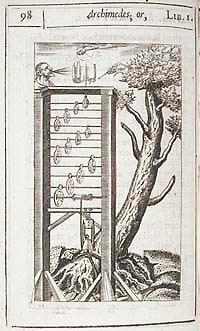John Wilkins (1614–72) became Warden of Wadham College, Oxford in 1648, following the deprivation of his predecessor by the Parliamentary Visitors. In 1656, he married Cromwell’s younger sister, and in 1659 was made Master of Trinity College, Cambridge. Although he had to relinquish that position after the Restoration, he rose rapidly in the Church of England to become Bishop of Chester in 1668. Wilkins was noted for his wide intellectual interests, his skill with the pen, his ability as an organizer, and his moderation in religion. These qualities ensured his success during a period of constant political and religious upheaval in which Wilkins proved himself zealous in defence of the universities and dextrous in negotiations about religious conformity.
Both at Wadham and in London, Wilkins was instrumental in organizing gatherings of individuals with interests in the new natural philosophy. He was closely involved in the foundation and early activities of the Royal Society after 1660, and many of those he had patronized at Oxford subsequently became Fellows of that body. His own reputation was founded on a series of works published in the 1630s and 1640s which discussed discoveries made with new scientific instruments, such as the telescope, and helped to popularize new ideas, like the Copernican system in astronomy. Wilkins was an early enthusiast for the writings of Francis Bacon, and, before he moved to Oxford, had been involved with a group of natural philosophers who met in London from 1645. He had intended to establish a ‘Mathematico-Chymico-Mechanical School’, and Samuel Hartlib expected him to be appointed president of the standing council of an Agency for the Advancement of Universal Learning which was being canvassed in the late 1640s. Wilkins’ interests encompassed a range of Baconian and Comenian themes. These included the reform of education, the invention of a real character and universal language (see catalogue no.42 ), agricultural and technological improvement, and religious reconciliation. Like many within the Hartlib circle, Wilkins was a firm believer in the value of knowledge gained from experiment.

|
|
Wilkins’ interest in technology is most apparent in his book, Mathematicall Magick. This work described a number of complex technical devices, and shows that their functioning depended on the operation of a few mechanical laws. It sought to open the way for further technological improvement by demystifying the operations of machines which had previously been kept secret. In places, it was an overly optimistic book, assuming that it would be easy to scale up models into working devices, and underestimating problems caused by friction and other restrictions on the perfect operation of mechanical laws. Such criticisms could certainly be applied to the device illustrated on page 98 of Mathematicall Magick (see figure13, p.47). This is a system of cogs and a pulley, harnessed to a sail, designed to channel a force as slight as the breath of a human being so that it might lift an oak tree by the roots. Although it was not a practi cal device, it did serve to illustrate the ways in which brute force could be aided by the operation of pulleys (Evelyn illustrated a not-totally-dissimilar device for uprooting trees in the second edition of his Sylva, see catalogue no.17). Wilkins observed the operation of new agricultural machines near Oxford, and in 1653 had given money to try to establish a repository for scientific instruments and mechanical devices in the University. He also displayed many cunning devices in the Lodgings and gallery at Wadham, where he carried out experiments on perpetual motion.
Much of Mechanicall Magick discusses the operation of machines for raising water, such as those which Wilkins had in his garden at Wadham. In general, the book embodied the notion that the quality of human life could easily be improved through the application of experimental knowledge. This was an idea that many linked to the reestablishment of mankind’s dominion over nature, which had been lost at the Fall. |
Barbara Shapiro, John Wilkins 1614–1672 (Berkeley and Los Angeles, 1969); Charles Webster, The Great Instauration (London, 1975), pp.88–99,160–4,&170–2; Hartlib Papers, 62/23/1A–4B, 62/50/5A–6B, 67/11A–B.
|




